Abstract
Iodine deficiency disorders are one of the commonest preventable human health problems. Producing iodine-enriched crops could be an effective way to reduce their epidemicity in many regions. However, the actual knowledge on this issue is limited mostly to studies involving grain crops and inorganic iodine fertilizers such as I− and IO −3 . Moreover, the translocation, transformation and distribution of iodine from soil to plants are not well understood. Here, we studied iodine transfer from soil to vegetables using both inorganic iodine (KI) and organic, seaweed iodine. Greenhouse culture experiments were undertaken to assess the absorption and accumulation of iodine by four vegetables: Chinese cabbage, lettuce, tomato and carrot. We also investigated the dynamic variation of exogenous iodine in soil by applying KI and a composite of seaweed and diatomite. Our results show first that iodine levels in vegetables increase with the increasing addition of iodine. Second, the iodine content in the edible portion ranks as follows: Chinese cabbage (high I) > lettuce > carrot > tomato (low I). The iodine accumulation in the edible portion of the cabbage is thus 2.25 and 4.45 times higher than that of lettuce and carrot, respectively, and 19.67 times higher than that of tomato. In vegetable tissues the iodine distribution is ranked as: root (high I) > leaf > stem > fruit (low I), except for carrot, where the average iodine level in the rhizome is 50% of the shoot. Third, vegetable growth is inhibited when the added iodine concentration is higher than 50 mg kg−1. The order of tolerance against iodine toxicity is ranked as: carrot (high tolerance) > Chinese cabbage > lettuce > tomato (low tolerance). Fourth, the seaweed composite iodine fertilizer demonstrates more potential of durability than KI. Indeed, when KI is added to the soil at 150 mg kg−, the biomass of cabbage, lettuce, tomato and carrot decreases by 34.8%, 41.3%, 46.8% and 17.9%, respectively. By comparison, the biomass decreases are lower, 16.6%, 22.9%, 23.4% and 9.7%, respectively, when applying the seaweed composite. Fifth, after harvest, the residual iodine in soil fertilized with KI is only 56% of the initial addition, which is less than that for seaweed composite. This study is of theoretical importance to understand iodine biogeochemistry and its transfer behavior, and also has practical implications for seeking effective alternatives of iodine biofortification to prevent iodine deficiency disorders.
Similar content being viewed by others
References
Ashmore C.B., Gwyther J.R., Sims H.E. (1996) Some effects of pH on inorganic iodine volatility in containment, Nucl. Eng. Des. 166, 347–355.
Dai J.-L., Zhu Y.-G., Zhang M., Huang Y.-Z. (2004) Selecting iodine-enriched vegetables and the residual effect of iodate application to soil, Biol. Trace Elem. Res. 101, 265–276.
Dai J.-L., Zhu Y.-G., Huang Y.-Z. (2006) Availability of iodide and iodate to spinach (Spinacia oleracea L.) in relation to total iodine in soil solution, Plant Soil 289, 301–308.
Delange F. (1998) Risks and benefits of iodine supplementation, Lancet 351, 923–924.
DeLong G.R., Leslie P.W., Wang S.-H., Jiang X.M., Zhang M.L., Rakeman M., Jiang J.Y., Ma T. (1997) Effect on infant mortality of iodination of irrigation water in a severely iodine-deficient area of China, Lancet 350, 771–773.
Graham R.D., Senadhira D., Beebe S., Iglesias C., Monasterio I. (1999) Breeding for micronutrient density in edible portions of staple food crops: conventional approaches, Field Crop. Res. 60, 57–80.
Gregorio G.B., Senadhira D., Htut T., Graham R.D. (2000) Breeding for trace mineral density in rice, Food Nutr. Bull. 21, 382–386.
Hetzel B.S. (1983) The iodine deficiency disorders (IDD) and their eradication, Lancet 2, 1126–1129.
Hou X., Chai C., Qian Q. (1998) Determination of chemical species of iodine in some seaweed, Oceanogr. Literature Rev. 45, 243–244.
Huang Y.-Z., Zhu Y.-G., Hu Y., Liu Y.-X., Dai J.-L. (2003) Iodine in soil—plant systems and prevention of iodine deficiency disorders, Ecol. Environ. 12, 228–231 (in Chinese).
Mackowiak C.L., Grossl P.R. (1999) Iodate and iodide effects on iodine uptake and partitioning in rice (Oryza sativa L.) grown in solution culture, Plant Soil 212, 135–143.
National Feedstuff Quality Supervision and Inspection Center (NFQSIC) (1992) Method for the determination of iodine in feedstuffs — Ferric thiocyanate—nitric acid catalytic kinetic method (GB/T 13882-92), Standards Press of China, Beijing (in Chinese).
Poletti S., Gruissem W., Sautter C. (2004) The nutritional fortification of cereals, Curr. Opin. Biotech. 15, 162–165.
Wang F.-R., Ilixat Ma L., Yang C.-Z., Yerkin, Mèliyam, Palidan, Jiang J.-Y., Hai X., Gülina, Shania, Xu X.-F., Malia (2000) 1999 survey of the iodine deficiency disorders in Xinjiang Province, China, Endemic Diseases Bull. 15, 59–61 (in Chinese).
Wang J.-E, Duan L.-Z., Liu N.-H. (1999) Determination of micro amounts of iodine in soil by amplified reaction colorimetric method, Anal. Laboratory 18, 71–74 (in Chinese).
Welch R.M. (2005) Agriculture: the real nexus for enhancing bioavailable micronutrients in food crops, J. Trace Elem. Med. Bio. 18, 299–307.
Weng H.-X., Cai Q.-X. (1998) A manufacture method of iodine composite fertilizer. Invention Patent in China, Grant No. ZL 94108836.7 (in Chinese).
Weng H.-X., Weng J.-K., Yong W.-B., Sun X.-W. (2003) Capacity and degree of iodine absorbed and enriched by vegetable from soil, J. Environ. Sci. 15, 107–111.
Zhang L.-J., Chen Z.-W., Wang J.-Y., Bao J.-M. (2000) Iodine loss from iodized salt during processing, sale and consumption, Zhejiang J. Preventive Med. 12, 32–34 (in Chinese).
Zhu Y.-G., Huang Y.-Z., Hu Y., Liu Y.-X. (2003) Iodine uptake by spinach (Spinacia oleracea L.) plants grown in solution culture: effects of iodine species and solution concentrations, Environ. Int. 29, 33–37.
Ziegler E.E., Filer Jr. L.J. (1996) (Eds.) Present Knowledge of Nutrition (7th ed.), ILSI Press, Washington DC, pp. 361–365.
Author information
Authors and Affiliations
Corresponding author
About this article
Cite this article
Hong, CL., Weng, HX., Qin, YC. et al. Transfer of iodine from soil to vegetables by applying exogenous iodine. Agron. Sustain. Dev. 28, 575–583 (2008). https://doi.org/10.1051/agro:2008033
Accepted:
Issue Date:
DOI: https://doi.org/10.1051/agro:2008033




